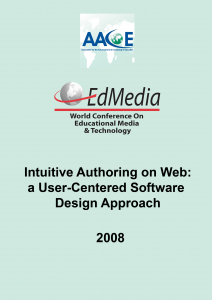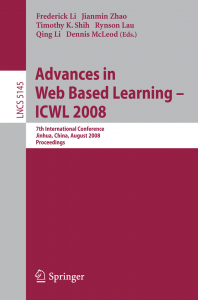Publikationen
Nazemi, Kawa; Cukusic, Maja; Granic, Andrina eLearning 2.0 - Technologies for Knowledge Transfer in European-Wide Network of Schools Artikel In: Journal of Software, Bd. 4, Nr. 2, S. 108–115, 2009, ISSN: 1796-217X. Abstract | Links | BibTeX | Schlagwörter: Case study, E-Learning, Knowledge management (KM), Web 2.0 Nazemi, Kawa; Hornung, Christoph Intuitive Authoring on Web: A User-Centered Software Design Approach Konferenz Proceedings of ED-Media 2008, The Association for the Advancement of Computing in Education (AACE), 2008. Abstract | Links | BibTeX | Schlagwörter: Human-computer interaction (HCI), Intuitive interaction, Prototyping, Software development process, User interfaces Hornung, Christoph; Granić, Andrina; Ćukušić, Maja; Nazemi, Kawa eKnowledge Repositories in eLearning 2.0: UNITE - a European-Wide Network of Schools Buchkapitel In: Li, F.; Zhao, J.; Shih, T. K; Lau, R.; Li, Q.; McLeod, D. (Hrsg.): Advances in Web Based Learning - ICWL 2008: 7th International Conference, Jinhua, China, August 20-22, 2008. Proceedings, S. 99–110, Springer Berlin Heidelberg, Berlin, Heidelberg, 2008, ISBN: 978-3-540-85033-5. Abstract | Links | BibTeX | Schlagwörter: Computer based learning, Intelligent Systems, Intelligent tutoring systems, reference model, Vocational training Nazemi, Kawa; Bhatti, Nadeem; Godehardt, Eicke; Hornung, Christoph Adaptive Tutoring in Virtual Learning Worlds Konferenz Proceedings of ED-Media 2007, The Association for the Advancement of Computing in Education (AACE), 2007, ISBN: 1-880094-62-2. Abstract | Links | BibTeX | Schlagwörter: Computer based learning, Intelligent training systems, Intelligent tutoring, Intelligent tutoring systems, Vocational training2009
@article{Nazemi2009c,
title = {eLearning 2.0 - Technologies for Knowledge Transfer in European-Wide Network of Schools},
author = {Kawa Nazemi and Maja Cukusic and Andrina Granic},
url = {https://kawa.nazemi.net/wp-content/uploads/2018/01/eLearning-2.0-Technologies-for-Knowledge-Transfer-in-European-Wide-Network-of-Schools.pdf, Full Paper
https://dx.doi.org/10.4304/jsw.4.2.108-115},
doi = {10.4304/jsw.4.2.108-115},
issn = {1796-217X},
year = {2009},
date = {2009-01-01},
journal = {Journal of Software},
volume = {4},
number = {2},
pages = {108--115},
publisher = {International Academy Publishing},
abstract = {With the upcoming features of Web 2.0 current eLearning solutions, mostly characterized by single user and centered data-download, change and develop further. The traditional paradigm of classroom teaching and learning is broadened towards sharing experiences and knowledge in word-wide social communities. Furthermore, knowledge capturing in ambient environments gains more importance and the use of mobile devices has created rich and exciting learning opportunities. These aspects characterize the so-called eLearning 2.0. Different aspects of this paradigm shift are presented in this paper and the European Community supported UNITE project as an application case is offered. The technical aspects of the platform development cycle are provided and its enhanced eKnowledge repositories are addressed. The UNITE system implementation in the setting of one of the European-wide network of schools is presented as an iterative four-stage-process, the achieved results are discussed and
future work is proposed.},
keywords = {Case study, E-Learning, Knowledge management (KM), Web 2.0},
pubstate = {published},
tppubtype = {article}
}
future work is proposed.2008
@conference{C34-P-19891,
title = {Intuitive Authoring on Web: A User-Centered Software Design Approach},
author = {Kawa Nazemi and Christoph Hornung},
url = {https://www.learntechlib.org/noaccess/28572/
https://publica.fraunhofer.de/dokumente/N-85712.html},
year = {2008},
date = {2008-01-01},
booktitle = {Proceedings of ED-Media 2008},
pages = {1440-1448},
publisher = {The Association for the Advancement of Computing in Education (AACE)},
abstract = {To motivate users to work with computer-based systems, to enhance their usage frequency, and to avoid that users get frustrated while working with computer-based systems, it is necessary to respond to the users as much as possible. User-centered software approaches try to assume all the wishes and demands of users. This paper presents a step-by-step introduction to a user-centered software development process. First, a definition of the term "intuitive" in the context of software development will be given. Furthermore, the development process will be explained as a combination of existing user-centered design processes. The implementation of an authoring tool in the European UNITE project, which uses the presented design approach, gives an insight into the development process and the results of the design approach.},
keywords = {Human-computer interaction (HCI), Intuitive interaction, Prototyping, Software development process, User interfaces},
pubstate = {published},
tppubtype = {conference}
}
@inbook{Hornung2008,
title = {eKnowledge Repositories in eLearning 2.0: UNITE - a European-Wide Network of Schools},
author = {Christoph Hornung and Andrina Granić and Maja Ćukušić and Kawa Nazemi},
editor = {F. Li and J. Zhao and T. K Shih and R. Lau and Q. Li and D. McLeod},
url = {https://doi.org/10.1007/978-3-540-85033-5_11
https://link.springer.com/chapter/10.1007/978-3-540-85033-5_11},
doi = {10.1007/978-3-540-85033-5_11},
isbn = {978-3-540-85033-5},
year = {2008},
date = {2008-01-01},
booktitle = {Advances in Web Based Learning - ICWL 2008: 7th International Conference, Jinhua, China, August 20-22, 2008. Proceedings},
pages = {99--110},
publisher = {Springer Berlin Heidelberg},
address = {Berlin, Heidelberg},
abstract = {The upcoming Web 2.0 technologies change the aspects of eLearning fundamentally. The traditional paradigm of classroom teaching and homework learning will develop further towards sharing experiences and knowledge in word-wide social communities. Moreover, knowledge capturing in ambient environments gains more and more importance. These aspects characterize the so-called eLearning 2.0. This paper describes a prototype of an eLearning 2.0 system covering the different aspects such as platform, pedagogy and scenarios. The concepts presented here have been applied in the EU-project UNITE. The implementation of this system in the setting of a European network of fourteen schools is presented as an iterative four stage process, covering scenario planning and implementation, validation in addition to platform and process improvement. Achieved intermediate results from the first iteration of the implementation process are discussed and future work is presented.},
keywords = {Computer based learning, Intelligent Systems, Intelligent tutoring systems, reference model, Vocational training},
pubstate = {published},
tppubtype = {inbook}
}
2007
@conference{C34-P-18730,
title = {Adaptive Tutoring in Virtual Learning Worlds},
author = {Kawa Nazemi and Nadeem Bhatti and Eicke Godehardt and Christoph Hornung},
url = {https://publica.fraunhofer.de/documents/N-66108.html
https://www.learntechlib.org/p/25795/},
isbn = {1-880094-62-2},
year = {2007},
date = {2007-01-01},
booktitle = {Proceedings of ED-Media 2007},
pages = {2951-2959},
publisher = {The Association for the Advancement of Computing in Education (AACE)},
abstract = {To enhance the learning success of the learners in the Virtual Learning Worlds (VLW) and effective of VLW, the aspects like precognition and learning aptitude of the learners play a key role. The constructivistic approach based VLW not only offers learning, but also great experience by exploring through reality based virtual worlds. VLWs can be extended with such a Learning Environment. They are Novices or Beginner and need more explanations and instructions to understand a topic and resolve a given problem.
An Adaptive Tutoring System tries to find out the differences in precognitions and learning aptitudes and offers the learning task depending on these parameters. In the following paper a new system is designed for adapting a VLE to learners' need and presenting the learning tasks based on the recommended pedagogical approach.},
keywords = {Computer based learning, Intelligent training systems, Intelligent tutoring, Intelligent tutoring systems, Vocational training},
pubstate = {published},
tppubtype = {conference}
}
An Adaptive Tutoring System tries to find out the differences in precognitions and learning aptitudes and offers the learning task depending on these parameters. In the following paper a new system is designed for adapting a VLE to learners' need and presenting the learning tasks based on the recommended pedagogical approach.




